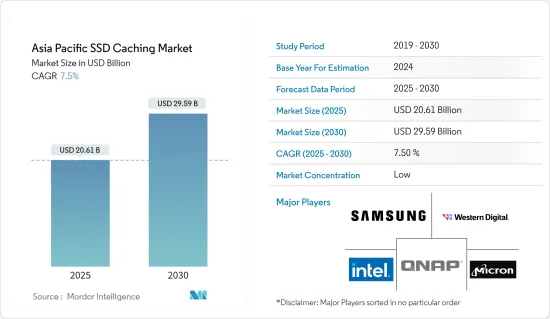Need help finding what you are looking for?
Contact Us
PUBLISHER: Mordor Intelligence | PRODUCT CODE: 1637767

PUBLISHER: Mordor Intelligence | PRODUCT CODE: 1637767
Asia Pacific SSD Caching - Market Share Analysis, Industry Trends & Statistics, Growth Forecasts (2025 - 2030)
PUBLISHED:
PAGES: 100 Pages
DELIVERY TIME: 2-3 business days
SELECT AN OPTION
The Asia Pacific SSD Caching Market size is estimated at USD 20.61 billion in 2025, and is expected to reach USD 29.59 billion by 2030, at a CAGR of 7.5% during the forecast period (2025-2030).

SSD caching involves using solid-state drives (SSDs) to accelerate the performance of traditional hard disk drives (HDDs) in computer systems. This technology aims to combine the speed of SSDs with the storage capacity of HDDs to enhance overall system performance, especially for applications that require fast data access.
Key Highlights
- The increasing digitization of businesses and the general population's reliance on technology have led to higher demands for faster data access and storage solutions. Many countries in the Asia Pacific region have been investing in improving their technological infrastructure, including network connectivity and data centers. This provided a favorable environment for SSD caching to thrive.
- The growth of E-commerce platforms, online streaming services, and other content consumption platforms drove the need for efficient data storage and retrieval, pushing businesses to consider SSD caching to enhance user experiences.
- The improvements offered by SSDs align with the demands of various industries and the growing need for faster, more reliable, and energy-efficient storage solutions in the Asia Pacific region. As a result, SSD caching, which leverages these SSD benefits to enhance HDD performance, has been gaining traction in the market.
- SSDs tend to be more expensive than traditional HDDs on a per-gigabyte basis. This cost differential can be challenging, especially for businesses or individuals adopting SSD caching solutions. While SSDs generally offer low-latency performance compared to traditional HDDs, there can be variability in performance across different SSD models, brands, and even generations of SSD technology.
APAC SSD Caching Market Trends
Enterprise Storage Application Segment is Expected to Hold Significant Market Share
- Enterprises in the Asia Pacific region were increasingly adopting SSD caching to enhance the performance of their storage systems. SSD caching helps accelerate data retrieval, improving application responsiveness and reducing latency. This is particularly crucial for mission-critical applications, databases, and virtualized environments.
- Data centers and cloud services providers in the Asia Pacific region focused on optimizing their infrastructure to meet the rapidly growing digital services demand. SSD caching improved the efficiency and speed of data processing in these environments, contributing to a better user experience. According to Cloudscene, as of January 2022, 443 data centers were in China.
India is Expected to Hold Significant Market Share
APAC SSD Caching Industry Overview
Additional Benefits:
Product Code: 46906
TABLE OF CONTENTS
1 INTRODUCTION
- 1.1 Study Assumptions and Market Definition
- 1.2 Scope of the Study
2 RESEARCH METHODOLOGY
3 EXECUTIVE SUMMARY
4 MARKET INSIGHTS
- 4.1 Market Overview
- 4.2 Industry Attractiveness - Porter's Five Forces Analysis
- 4.2.1 Threat of New Entrants
- 4.2.2 Bargaining Power of Buyers
5 MARKET DYNAMICS
6 MARKET SEGMENTATION
7 COMPETITIVE LANDSCAPE
8 INVESTMENT ANALYSIS
9 FUTURE OF THE MARKET
Have a question?


SELECT AN OPTION
Have a question?


Questions? Please give us a call or visit the contact form.
